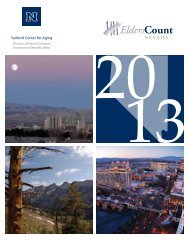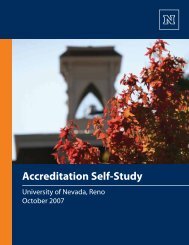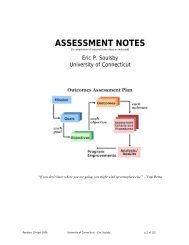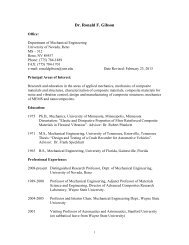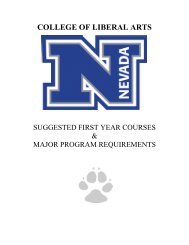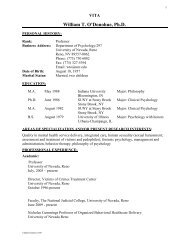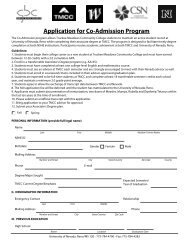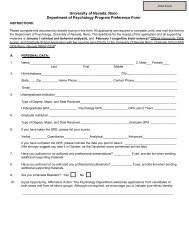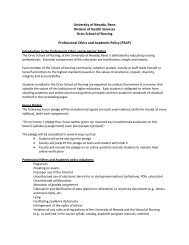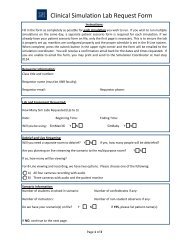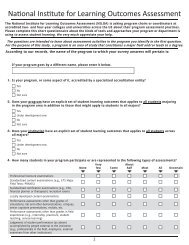Transportation & Infrastructure - University of Nevada, Reno
Transportation & Infrastructure - University of Nevada, Reno
Transportation & Infrastructure - University of Nevada, Reno
Create successful ePaper yourself
Turn your PDF publications into a flip-book with our unique Google optimized e-Paper software.
NDOT also is responsible for 20% <strong>of</strong> <strong>Nevada</strong>’s<br />
roads with over half <strong>of</strong> all vehicle miles traveled on<br />
NDOT-maintained roads. In 2007 and 2009, ASCE<br />
graded the U.S. road infrastructure with a “D” and a<br />
“D-” for poor-to-mediocre road conditions that cost<br />
Americans time and fuel and increase stress due to<br />
congestion. The conditions also cost motorists money<br />
in terms <strong>of</strong> road-induced need for auto repairs (see<br />
Table T3).<br />
In 2009, the American Recovery and Reinvestment<br />
Act allocated approximately $201 million to the<br />
<strong>Nevada</strong> Department <strong>of</strong> <strong>Transportation</strong> to improve<br />
the state’s transportation infrastructure and put<br />
<strong>Nevada</strong> residents back to work (NDOT: Projects and<br />
Programs, American Recovery and Reinvestment Act<br />
Overview, 2012). Approximately 30% <strong>of</strong> the money<br />
was allocated for transportation projects in the urban<br />
areas <strong>of</strong> the state (e.g., Clark and Washoe counties);<br />
3.5% was allocated to rural areas; and the remaining<br />
money was earmarked for other statewide projects.<br />
The 2011 Urban Mobility Report suggested that<br />
demand for new road construction and infrastructure<br />
repair in Las Vegas outstripped supplies by 30%<br />
(Schrank, Lomax, & Eisele, p. 50). In addition, in a<br />
review <strong>of</strong> 101 U.S. cities, Las Vegas ranked 36th in<br />
terms <strong>of</strong> traffic congestion. This resulted in 28 hours<br />
<strong>of</strong> delay per commuter annually, seven gallons <strong>of</strong><br />
excess fuel per auto per year, and an estimated $532<br />
total annual cost per auto (Schrank, et al., 2011).<br />
These congestion figures translate into a total annual<br />
congestion cost <strong>of</strong> $530 million in <strong>Nevada</strong> when the<br />
excess fuel costs are taken into account and delays<br />
are valued at $16 per hour for individuals and $88 per<br />
hour for large commercial trucks.<br />
In 2011, NDOT embarked on the second phase <strong>of</strong><br />
the two-part, multi-agency study called Connecting<br />
<strong>Nevada</strong>. A goal <strong>of</strong> this study was to redefine<br />
<strong>Nevada</strong>’s transportation-planning process through<br />
collaboration with federal, state, regional and local<br />
agencies and stakeholders. Another goal was to<br />
improve <strong>Nevada</strong>’s transportation network for seniors<br />
and future generations.<br />
Tasks <strong>of</strong> the study included increasing public and<br />
stakeholder involvement in planning for <strong>Nevada</strong>’s<br />
future transportation needs through formal needs<br />
analysis and group discussion, and development <strong>of</strong><br />
a statewide travel-demand model, population and<br />
employment forecasts, and web map. The study<br />
was expected to be completed in the first quarter<br />
<strong>of</strong> 2013 followed by data analysis and planning. At<br />
the time <strong>of</strong> the publication <strong>of</strong> Elders Count <strong>Nevada</strong><br />
(2013), the project had connected with more than 150<br />
stakeholders across the state. For more information,<br />
please see www.connectingnevada.org.<br />
TRANSPORTATION & INFRASTRUCTURE<br />
35



